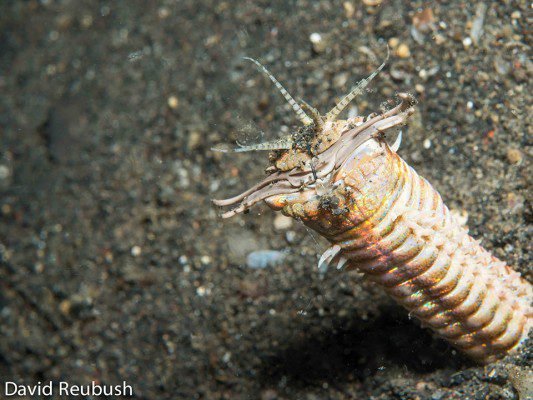
If you’re new to marine biology or just curious about the world beneath the waves, you’re in for a treat. Today, we’re diving into the life of Bobbit worms and exploring their nighttime hunts. So, grab your favorite beverage and let’s get started!
What Are Bobbit Worms?
Bobbit worms, or *Eunice aphroditois*, are marine polychaete worms known for their size and predatory prowess. They can grow up to 10 feet long! These worms live mostly in tropical and subtropical waters, burrowing into the sediments of the ocean floor. Their bodies are segmented and adorned with colorful bristles, making them visually stunning, albeit a bit intimidating.
Here’s the thing: Bobbit worms are named after a rather infamous incident involving a pair of scissors and a certain John Wayne Bobbitt. However, the name actually comes from the worm’s aggressive nature and ability to strike quickly. They’re not just harmless underwater creatures—their feeding habits are a true testament to their predatory nature.
Fun fact: Bobbit worms can regenerate lost body segments! If they lose a part of their body to a predator, they can grow it back. Talk about resilience!
How Do Bobbit Worms Feed?
Bobbit worms are ambush predators, meaning they wait for their prey to come close before launching a surprise attack. They spend most of their time hidden in their sandy burrows, with just their tasty-looking heads and tentacles exposed. To the unsuspecting fish or crustacean, it might seem like an easy meal. But that’s where they make a big mistake!
When a fish swims too close, the Bobbit worm reacts in a flash. With lightning speed, it lashes out, grabbing its prey with sharp, powerful jaws. Once captured, the worm pulls the prey back into its burrow for a meal. This feeding strategy is remarkably effective, allowing Bobbit worms to thrive in their environment.
You might be wondering why they hunt at night. Well, that’s because many of their prey are also nocturnal. By aligning their feeding patterns with those of other sea creatures, Bobbit worms increase their chances of a successful catch.
Nocturnal Feeding Patterns Explained
Now, let’s dive deeper into those nocturnal feeding habits. Why do Bobbit worms choose to hunt under the cover of darkness? One reason is that many of their preferred prey, like small fish and crustaceans, are more active at night. These creatures venture out to feed when it’s cooler and darker, making them easier targets for the Bobbit worm.
Additionally, nighttime hunting helps Bobbit worms avoid larger predators. The ocean can be a dangerous place, and many animals are looking for their next meal. By staying hidden and only hunting at night, Bobbit worms reduce their chances of being discovered by animals that might want to snack on them instead.
Imagine it like this: if you were a stealthy ninja in a world full of predators, you’d probably choose to do your best work under the cover of night, right? That’s exactly what these worms do!
The Role of Bobbit Worms in the Ecosystem
Bobbit worms play an important role in their underwater environments. As predators, they help maintain the balance of the ecosystem by keeping the population of smaller fish and crustaceans in check. Without creatures like the Bobbit worm, the ocean might see an overpopulation of certain species, which can lead to food shortages for others.
Moreover, their burrowing behavior contributes to ocean floor health. By digging into the sediments, Bobbit worms aerate the soil and help decompose organic material. This process enriches the environment, allowing various marine organisms to thrive.
You might not think about it often, but every creature in the ocean plays a part in its health and balance. Bobbit worms are just one piece of that puzzle!
Care Tips for Bobbit Worms in Aquariums
If you’re thinking about keeping a Bobbit worm in an aquarium, there are a few things to consider. First and foremost, they require a sizable tank with plenty of hiding spots. Bobbit worms need space to burrow, so a sandy substrate is essential.
Here’s a quick list of tips for keeping Bobbit worms in captivity:
- Provide a large tank (at least 40 gallons) for them to thrive.
- Use a sandy substrate to mimic their natural habitat.
- Ensure the water is clean and well-oxygenated.
- Keep the tank conditions stable, avoiding sudden changes in temperature.
Honestly, keeping a Bobbit worm can be a fascinating experience, but they do require special care. They might not be the best choice for beginner aquarists, as their predatory nature can lead to issues with smaller tank mates.
Bobbit worms are one of nature’s extraordinary wonders. Their unique nocturnal feeding patterns and impressive adaptations allow them to thrive in the often harsh conditions of the ocean. As both predators and important contributors to their ecosystems, these creatures remind us of the intricate balance of marine life.
Next time you think about the ocean’s depths, remember the stealthy Bobbit worm lying in wait for its next meal. Nature can be both beautiful and brutal, and the Bobbit worm is a perfect example of that duality. So, whether you’re a marine biology enthusiast or just someone fascinated by the strange and wonderful creatures of our planet, there’s always something new to learn about the amazing world of Bobbit worms!
